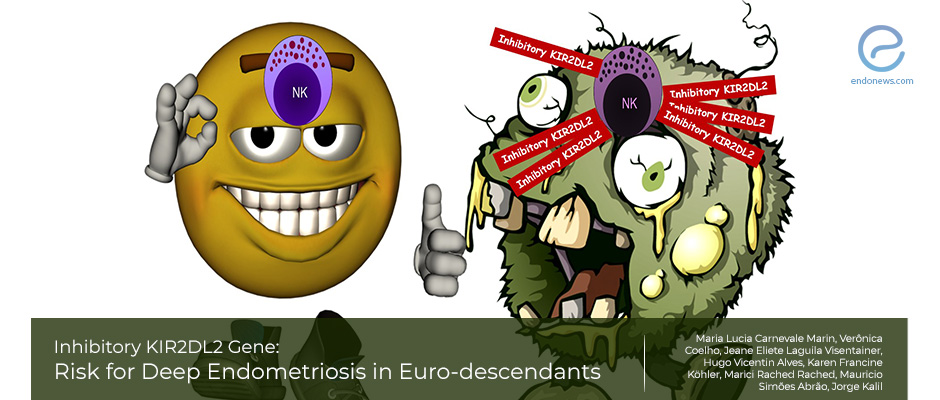Inhibiting killer on the move
Sep 2, 2020
Natural killer advantage
Key Points
Highlight:
- Gene alteration of a receptor in body defense cells -NK cells-, named KIR2DL2, is associated with risk for deep endometriosis in European descendant women.
Importance:
- Natural killer (NK) cells are large lymphocytes that are part of the innate immune response, important for eliminating foreign cells.
- In endometriosis, NK cell cytotoxic activity is reduced, and maybe one of the contributing factors to the endometriosis pathogenesis.
What has been done:
- Women with deep endometriosis (n=160) and 202 control women without the disease were enrolled. The deep endometriosis group was subdivided into initial and advanced stages.
- This study examined the KIR (Killer Cell Immunoglobulin-like Receptor) genes and Human Leukocyte Antigens (HLA) class I polymorphisms.
- Data were correlated with deep endometriosis diagnosis.
Results:
- Inhibitory KIR2DL2 gene conferred risk for deep endometriosis in European descendants.
- The presence of all five inhibitory KIR genes together (KIR2DL1, 2DL2, 2DL3, 2DL5, and 3DL1) was associated with deep endometriosis risk in Euro-descendants as compared to controls.
- These associations were not observed for women with Afro-descendants.
Limitation:
- The study population was largely Euro-descendants with smaller size samples of Afro-descendants. Therefore, the results may be unrepresentative of the larger Afro-descendent population.
Lay Summary
The three main forms of endometriosis are superficial, ovarian, and deep endometriosis. The latter is defined by the presence of endometriotic nodules that are deeper than 5 mm. Deep endometriosis is considered the most aggressive and is associated with severe symptoms of pain and infertility.
The immune system is increasingly found to be responsible for endometriosis because of its failure in eliminating refluxed endometrial fragments in the peritoneum. Research suggests that impaired immune function in women contributes to the inadequate clearance of endometrial fragments, leading to endometriosis.
Exactly what immune cells are allowing the escape of endometrial fragments? Two culprits were found, i.e., macrophages and natural killer (NK) cells.
The reduced cytotoxic activity of natural killer (NK) cells in women with endometriosis has been reported, but why these cells are defective in the first place is not well understood. NK cell activity and ability to kill other cells is regulated by several of its activating and inhibitory receptors, which bind to ligands on other target cells. Killer cell immunoglobulin-like receptors (KIR) are a group of NK receptors that recognizes human leukocyte antigens (HLA) class I.
Inhibitory KIR receptors can bind self-HLA class I molecules to enable NK cells to distinguish between healthy from diseased cells. For example, the reduced self-HLA molecules such as in tumor cells enable NK cells to kill these target cells. The problem is that KIR and HLA (A, B, C) molecules have a high degree of polymorphisms (genetic variations). Therefore, NK cell function can be largely influenced by these polymorphisms that affect KIR and HLA genes.
This study by Marin et al. from Laboratory of Immunology, Hospital das Clínicas HCFMUSP, Universidade de São Paulo, Brazil, aimed to investigate the KIR gene polymorphism and to determine whether this factor influence risk of a deep endometriosis diagnosis in a Brazilian population. This report was recently published in "Reproductive Sciences".
The study recruited 160 women with deep endometriosis and 202 control women, underwent laparoscopy for tubal ligation or other benign conditions. Blood samples were taken from the participants to carry out KIR and HLA Class I genotyping.
The results showed that the higher frequency of inhibitory KIR2DL2 gene is associated with deep endometriosis in Euro-Descendants women. The authors also investigated whether the frequency of inhibitory and activating KIR genes and their gene ratios contribute to a risk for deep endometriosis.
These other KIR genes include inhibitory genes: KIR2DL1, 2DL2, 2DL3, 2DL5, and 3DL1 and activating genes: KIR2DS1, 2DS2, 2DS3, 2DS5, 3DS1. The examination showed that the presence of all five inhibitory KIR genes altogether was associated with deep endometriosis as compared to controls.
In summary, this study suggests that polymorphism in NK cell inhibitory receptor genes may be an important factor contributing to the occurrence of deep endometriosis in women with a European background. The study was not large enough to draw a conclusion on women with Afro-descendants. Altogether, this study, together with others, suggest the importance of NK cells cytotoxic function in keeping away endometriosis.
Research Source: https://pubmed.ncbi.nlm.nih.gov/32661880/
go away deep endometriosis endometriosis stages early stage advanced stage polymoprhism activating genes HLA natural killer KIR european descendent

